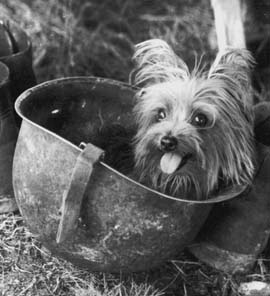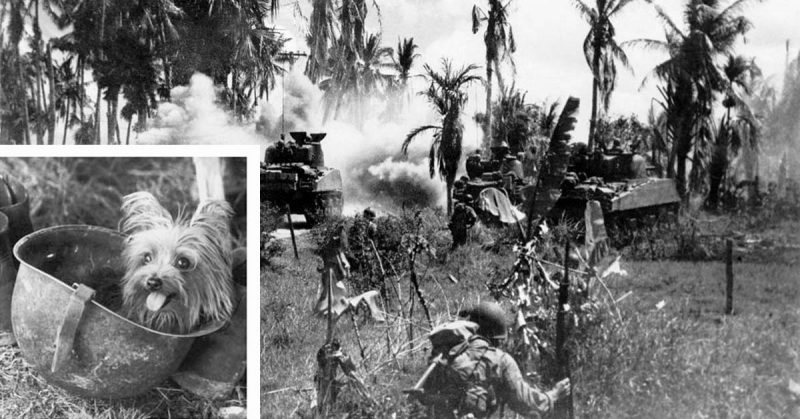William “Bill” Wynne was raised in Cleveland, Ohio, during the Great Depression. His father had left him and his mother couldn’t afford to raise him, so he was placed in an orphanage for a while. He spent a lot of his time in the streets, bonding with stray dogs.
Smoky is one of the most famous dogs from World War II. He received several citations from the military, was featured on TV, has books and articles written about him and has monuments erected in his honor around the world.
Wynne, now 95, was just out of high school and working at a steel mill when he was drafted into the US Army Air Corps. It was near the end of WWII when Nazi Germany was putting up its last gasp but the Japanese were still a formidable foe.
Wynne had a talent for photography so he was made an aerial surveyor, mapping out the terrain prior to a bombing run. He was stationed at New Guinea in March 1944 when a fellow airman brought him a stray dog he had found.
The other man’s Jeep had broken down in the jungle. While stopped, he heard a yapping and saw the pup trying to climb out of a disused foxhole. Through a series of efforts, Wynne ended up the dog’s new owner.
The dog was a four-pound Yorkshire terrier that Wynne named Smoky.

Wynne spent his free time teaching Smoky to do tricks. He taught her to sit and to stay. She eventually graduated to dropping out of trees in a homemade parachute, climbing ladders, going down slides, walking tightropes while blindfolded and picking out her name using alphabet blocks.
When Wynne came down with Dengue fever, he was laid up in a military hospital. Smoky was so popular, she was allowed to visit Wynne in the hospital. Eventually, she began to accompany the doctors and nurses as they made their rounds. She is the first recorded “therapy dog” in history.
Wynne submitted Smoky in a contest by Yank magazine to find the best companion animal in war zones. Smoky won for the Southwest Pacific region and began her rise to fame.
In January 1945, the US was preparing to invade the island of Luzon in the Philippines. To successfully pull off the invasion, the ground troops needed air support from the American bombers. They worked to put in an airstrip for the planes, but couldn’t run the telephone lines under it. The phone lines were needed to call in the airstrikes to remove Japanese defenses before the invasion could begin.
Wynne was asked if Smoky could pull a telephone cable through 70 feet of 8-inch wide pipe. Wynne knew she could but he only agreed when they promised to dig her out if she got stuck.
They tied the cable to Smoky’s chest and she went through the tunnel with Wynne calling out instructions and encouragement. According to Wynne, not one dog in 10,000 will go into an unfamiliar, dark tunnel. That is a measure of how unique Smoky was.
It wasn’t until three years later that the men at the base realized just how important Smoky’s act of bravery was. The Japanese had destroyed most everything around them. Without the air support that landing strip provided, their base would have been destroyed, too.
One time, when Smoky was with Wynne on a ship in a convoy of 2,300 that were headed to Luzon, a kamikaze attack destroyed part of the fleet. Smoky led Wynne to a Jeep just as the attack began. They lay down and waited while the deck bounced around them and the noise was terrible. After the attack, they found that a kamikaze pilot had just missed Wynne and several other men by inches, hitting an armor stack that saved their lives. 150 men behind them were killed.
Smoky flew on combat missions with Wynne so that the other men wouldn’t fight over who got to keep her if Wynne didn’t come back. She flew on 22-hour bombing missions so low, they threw grenades down on the Japanese.
After the war, Smoky continued to visit military hospitals for twelve years. Wynne went home and married his girlfriend, raised a family and worked as a dog trainer in Hollywood, The Chronicle reported.
The Wynnes raised nine children on Cleveland’s west side. Wynne took a job with the agency that would become NASA. Later, he would become a staff photographer with The Plain Dealer newspaper.
Smoky died in 1957. In 1996, Wynne self-published a book about Smoky called “Yorkie Doodle Dandy.”
The possibility of a feature film about Smoky is being explored.
